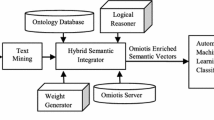Abstract
The W3C generally defines web services as: “software systems that are designed to support interoperable machine-to-machine interaction over a network”, web services can be published, located and accessed using web standard protocols such as: HTTP, SOAP protocols and UDDI which help in data exchange between other web applications. While Web has a huge number of unstructured and distributed services that belong to different domains, WSs Classification (WSC) becomes a significant task, which has brought a lot of interest in the past years as a research area. This paper introduces a new WSC strategy called semantic web service classification (SWSC). The proposed strategy simplifies the classification task by employing a novel dimensionality reduction methodology. This was accomplished by choosing the most descriptive concepts for each target domain class. Ineffective concepts are rejected through a proposed Concept Rejection Space Module. SWSC employs a new ontology based classification technique, which is called Semantic Similarity based Classifier (SSbC). SSbC adds several semantic relations among concepts of the employed domain ontology, and then benefits from these relations to classify an input web service accordingly. Experimental results have shown that SWSC outperforms recent web service classification strategies in terms of accuracy, precision, and recall.



























Similar content being viewed by others
References
Extensible markup language, W3C recommendation. http://www.w3.org/XML/
Simple object access protocol v1.2, W3C recommendation. http://www.w3.org/TR/soap/. Accessed 27 April 2007
Web services description language, W3C note (2001). http://www.w3.org/TR/wsdl
Tim, B.-L., Hendler, J., Lassila, O.: Scientific American Magazine. The Semantic Web. 284(5): 34–43 (2001)
Burstein, M., Bussler, C., Zaremba, M., Finin, T., Huhns, M.N., Paolucci, M., Sheth, A.P., Williams, S.: A semantic web services architecture. IEEE Int. Comput. 9(5), 72–81 (2005)
Christiensen, E. et al: Web service description language (WSDL), v1.1
Oldham, N., Thomas, C., Sheth, A., Verma, K.: METEOR-S web service annotation framework with machine learning classification. In: Proceedings of the 1st International Workshop on Semantic Web Services and Web Process Composition (SWSWPC’04), California, July 2004
Web ontology language for services, W3C member submission 2004. http://www.w3.org/Submission/OWL-S/
Web service modeling ontology (WSMO), W3C member submission (2005). http://www.w3.org/Submission/WSMO/
Johnston, H., Kushmerick, N.: Machine learning techniques for annotating semantic web services. In: Proceedings of the Dagstuhl Seminar on Machine Learning for the Semantic Web (2005)
Sebastiani, F.: Machine Learning in automated text categorization. ACM Comput. Surv. 34(1–47), 222 (2002)
Larkey, L.S., Croft, W.L Combining classifiers in text categorization. In: Proceedings of ACM SIGIR (1996)
Cheeseman, P., Stutz, J.: Bayesian Classification (Auto Class): theory and Results. Adv. Knowl. Discov. Data Min. 180, 153–180 (1996)
A decision tree approach to classify web services using quality parameters
Service classification using adaptive back-propagation neural network and semantic similarity IEEE
Web service classification using support vector machine IEEE 2010
Heß, A., Johnston, E., Kushmerick, N.: ASSAM: a tool for semi-automatically annotating semantic web services. In: Proceedings of 12th International Conference on Web Technologies, pp. 470–475 (2008)
Oldham, N., Thomas, C., Sheth, A., Verma, K.: METEOR-S web service annotation framework with machine learning classification. In: Proceedings of the 1st International Workshop on Semantic Web Services and Web Process Composition (SWSWPC’04), California, July 2004
Li, L., Horrocks, I.: A software framework for matchmaking based on semantic web technology. Int. J. Electron. Commer. 8(4), 39–60 (2004)
Paolucci, M., Kawamura, T., Payne, T., Sycara, K.: Semantic matching of web service capabilities. In: Proceedings of the First International Semantic Web Conference (2002)
Crasso, M., Zunino, A., Campo, M.: AWSC: an approach to web service classification based on machine learning techniques. In: Proceedings of 9th ASAI, Argentina (2007)
Yates, R.B., Neto, B.R.: Modern Information Retrieval. Addison Wesley Longman (1999)
Richardson, R., Smeaton, A., Murphy, J.: Using WordNet as a knowledge base for measuring semantic similarity between words. Technical Report Working paper, Dublin City University, Dublin, Ireland (1994)
Li, Y., Bandar, Z.A., McLean, D.: An approach for measuring semantic similarity between words using multiple information sources. IEEE Trans. Knowl. Data Eng. 15(4), 871–882 (2003)
Resnik, O.: Semantic similarity in a taxonomy: an information-based measure and its application to problems of ambiguity and natural language. J. Artif. Intell. Res. 11, 95–130 (1999)
Lord, P., Stevens, R., Brass, A., Goble, C.: Investigating semantic similarity measures across the gene ontology: the relationship between sequence and annotation. Bioinformatics 19(10), 1275–1283 (2003)
Tversky, A.: Features of similarity. Psycol. Rev. 84(4), 327–352 (1977)
Rodriguez, M., Egenhofer, M.: Determining semantic similarity among entity classes from different ontologies. IEEE Trans. Knowl. Data Eng. 15(2), 442–456 (2003)
Farrag, T.A., Saleh, A.I., Ali, H.A.: ASWSC: automatic semantic web services classifier based on semantic relations. In: Proceedings of the IEEE Seventh International Conference on Computer Engineering and Systems, ICCES’2011 (2011)
Farrag, T.A., Saleh, A.I., Ali, H.A.: Towards SWSs discovery: mapping from WSDL to OWL-S based on ontology search and standardization engine. IEEE Trans. Knowl. Data Eng. 25, 1135–1147 (2013)
Miller, G.A., Leacock, C., Tengi, R., Bunker, R.: A semantic concordance. In: Proceedings of the ARPA human language technology workshop, pp. 303–308. Princeton, NJ (1993)
Fellbaum, C. (ed): WordNet: An Electronic Lexical Database. MIT Press, Cambridge (1998)
WordNet (2009). http://wordnet.princeton.edu/
Cassar, G., Barnaghi, P., Moessner, K.: Probabilistic matchmaking methods for automated service discovery. IEEE Trans. Serv. Comput. 7(4), 654–666 (2014)
Forman, G.: An extensive empirical study of feature selection metrics for text classification. J. Mach. Learn. Res. 3, 1289–1305 (2003)
Forman, G.: An extensive empirical study of feature selection metrics for text classification. J. Mach. Learn. Res. 3, 1289–1305 (2003)
Hsu, C.-W., Lin, C.-J.: A comparison of methods for multiclass support vector machines. IEEE Trans. Neural Netw. 13, 415–425 (2002)
Martin, D., Domingue, J., Sheth, A., Battle, S., Sycara, K., et al.: Semantic Web services, part 2. IEEE Intell. Syst. 22, 8–15 (2007)
Author information
Authors and Affiliations
Corresponding author
Rights and permissions
About this article
Cite this article
El-Sayyad, S.E., Saleh, A.I. & Ali, H.A. A new semantic web service classification (SWSC) strategy. Cluster Comput 21, 1639–1665 (2018). https://doi.org/10.1007/s10586-018-2367-9
Received:
Revised:
Accepted:
Published:
Issue Date:
DOI: https://doi.org/10.1007/s10586-018-2367-9




